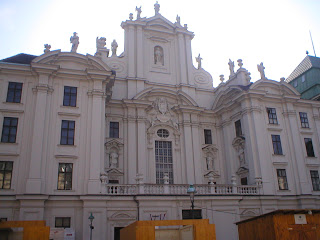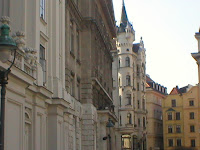
TWELFTH STOP:
CHURCH OF THE FRANCISCANS MINOR
At Minoritenplatz.
The Church of the Franciscans Minor has a very interesting facade with the tower at the very center of the architectural design. Adjoining this church is a two-room apartment where St. Clement and Bro. Stark were provided accomodation by Freiherr von Penkler, the priest assigned here at that time. They stayed here from 1808 to 1813.

The entrance to the church. In this church, St. Clement said his last Mass on 9 March 1820, a requiem Mass for his benefactress Princess Therese Jablonowka who had earlier died in Rome.

A memorial to St. Clement was set up outside the church.
This memorial was unveiled on 21 September 1913 during an open-air Mass celebrated by Archbishop Piffl. It was sculpted from marble by the sculptor Virgil Rainer.

This photo shows where the memorial is located in reference to the church. It is actually at the side of the church although it is clearly visible as one approaches the church.
Since the time of Joseph II, the church has been the National Church of the Italian community in Vienna.

The church's entrance.
First is the pulpit, which has the design of the era in which
it was made.
painting of Leonardo da Vinci, except that it is made up
of tens of thousands of small pieces of tiles.
dating back to the 15th or 16th centuries.

There are also very impressive stained glass windows.

Close-up of the mosaic of the Last Supper.
CHURCH ON THE COURT (KIRCHE AM HOF)
At the Platz Am Hof
It was in this church that St. Clement married the lawyer Dr. Franz Karl Wagner to Therese Edle von Neubauer on 26 July 1819. The fathers of this young couple belonged to the Hofbauer Circle.
This church was the scene of significant historical events. From 1386 to 1403, there was a Carmelite church that was built here. In 1554, the Jesuits took over the church and were incharge of it until they were dissolved by Pope Clement XIV.
Again a historical marker. On 31 March 1782 Pope Pius VI gave the urbi et orbi blessing from the loggia of the church. In 1783, the church was made a parish church. On 6 August 1806, the end of the Holy Roman Empire of the German Nation (with the renunciation of the German Imperial Crown by Franz II) was announced from the loggia of this church.

Again a historical marker. On 31 March 1782 Pope Pius VI gave the urbi et orbi blessing from the loggia of the church. In 1783, the church was made a parish church. On 6 August 1806, the end of the Holy Roman Empire of the German Nation (with the renunciation of the German Imperial Crown by Franz II) was announced from the loggia of this church.
In front of the Church on the Court
is a plaza with an interesting monument.
A flea market was being set up
while I visited this site.

The interior of the Church on the Court with the main altar and the pulpit.

An art improvisation was set up near the altar as part

The interior of the Church on the Court with the main altar and the pulpit.

An art improvisation was set up near the altar as part
of the Lenten celebration.
painting of the Mother and Child.

STANDARD BEARER'S HOUSE (FAHNRICHHOF)
Along SingerstraBe
Along SingerstraBe
This is the road along which this house was located.
The von Maul family lived here including Maria Elisabeth,
Maria Anna and Therese whom St. Clement met at St. Stephen's cathedral leading to their being his patron for his studies. For a while, St. Clement also lived here.

This door led to the building complex that was made up of several houses in Blutgasse and in SingerstraBe. In the large courtyard, one of the four associations of citizens would assemble, hence the name. In 1965, the renovation was completed and the houses are now private apartments and artists' studios.
Inside the church is the shrine to St. Clement located a a side chapel. There one sees a statue of St. Clement as he was laid to rest. This lifesize statue - made by the sculptor Joseph Gasser - was the original cover of the elevated sepulchre in the church. To make this statue more accessible to visitors, it was put up in an upright position in the new chapel. The pillow under the head and the fact that the legs are crossed indicate the original use.

The altar - sculpted by Oskar Jofiner - at the St. Clement shrine-chapel. the round altar with the reliquary inside was made in 1986 when the church was renovated.
The pedestal depicts the symbols of the four evangelists (man, eagle, lion and bull). The wings support the altar-top. All these symbolize St. Clement's motto: The Gospel must be preached anew.
Mother of Perpetual Help, also a
favorite spot for
churchgoers, visitors and pilgrims.
The main altar of the church.
ST. MARY'S CHURCH IN HEARNALS (MARIENKIRCHE)
Along Wichtelgasse
This is a Redemptorist foundation orginally meant to be a church dedicated to St. Clement. The foundation stone was laid in 1886. However, since the building was completed (April 1889) before St. Clement was canonized, it was consecrated to Our Lady of Perpetual Help. It was made a parish in 1937.

Across the church is a building that houses offices and service centers attached to the parish.
This is a Redemptorist foundation orginally meant to be a church dedicated to St. Clement. The foundation stone was laid in 1886. However, since the building was completed (April 1889) before St. Clement was canonized, it was consecrated to Our Lady of Perpetual Help. It was made a parish in 1937.

Across the church is a building that houses offices and service centers attached to the parish.

This is the chapel of the community inside the monastery adjacent to the church.

The back of the monastery.

A sign in this park indicates that this square is called the Klemens Hofbauer Platz. Also on the grounds there is the Klemenshaus, a center devoted to the social ministries of the parish.
There is also the St. Clement's altar where a lifesize statue of the saint is depicting him as priest and preacher.
SIXTEENTH STOP
CEMETERY OF THE ROMANTICS (ROMANTIKERFRIEDHOF)
At Maria Enzersdorf
This cemetery was laid out in 1784 near the pilgrimage church of Maria Enzersdorf which was originally in the midst of vineyards.
There is a chapel near the graveyard where St. Clement was buried. On the side of the chapel's entrance one reads about St. Clement.
The grounds of the cemetery was donated by Freiherr von Penkler who also provided St. Clement with his first accomodation with the Franciscans Minor and was a great patron of the Romantic School.
 St. Clement wanted to be buried here becuase his beloved model, Jesuit priest Fr. Diessbach, was also buried here.
St. Clement wanted to be buried here becuase his beloved model, Jesuit priest Fr. Diessbach, was also buried here.
Many of St. Clement's friends among them the families of Friedrich von Klinkowstrom, Josef von Pilat and Adam Muller lie buried nearby.

St. Clement's grave has been preserved but his mortal remains rested here only until 1862 (for 42 years) since these have been transferred to Maria am Gestade.

 St. Clement wanted to be buried here becuase his beloved model, Jesuit priest Fr. Diessbach, was also buried here.
St. Clement wanted to be buried here becuase his beloved model, Jesuit priest Fr. Diessbach, was also buried here.Many of St. Clement's friends among them the families of Friedrich von Klinkowstrom, Josef von Pilat and Adam Muller lie buried nearby.

St. Clement's grave has been preserved but his mortal remains rested here only until 1862 (for 42 years) since these have been transferred to Maria am Gestade.































No comments:
Post a Comment